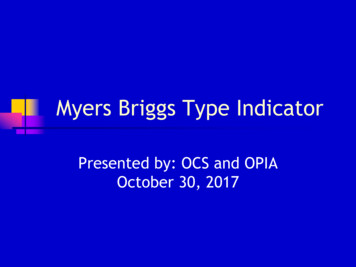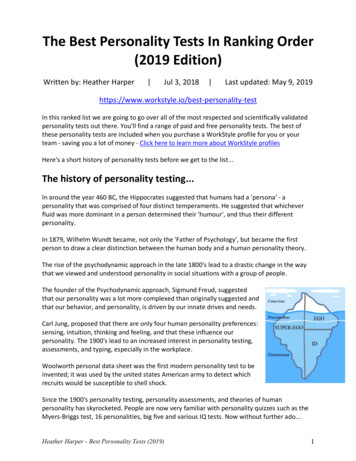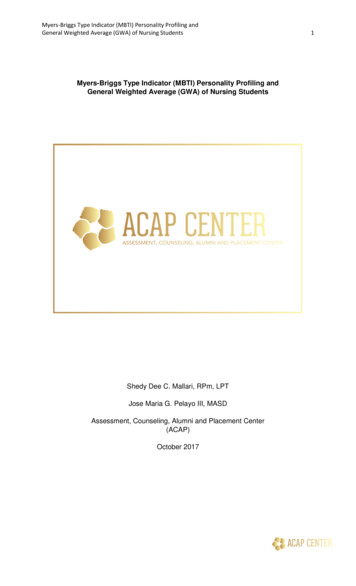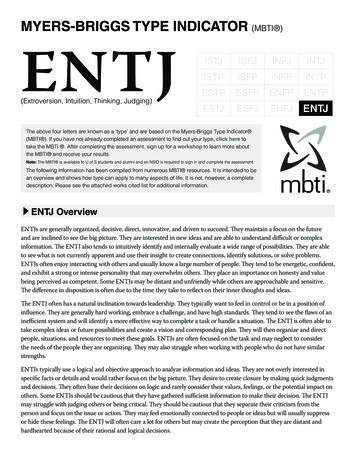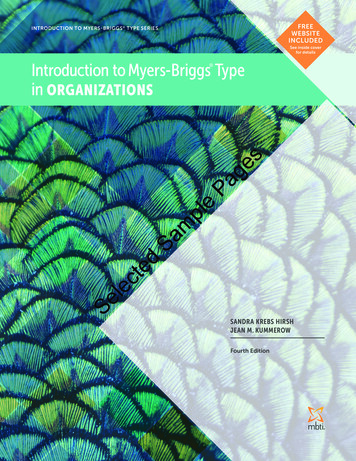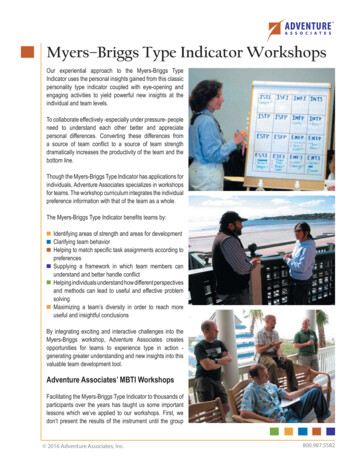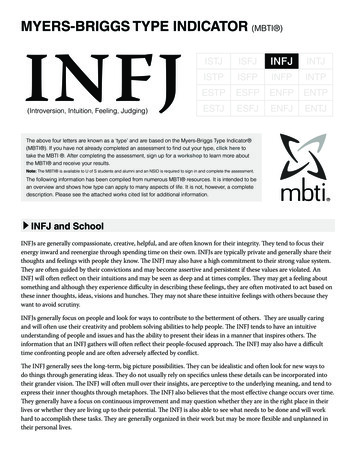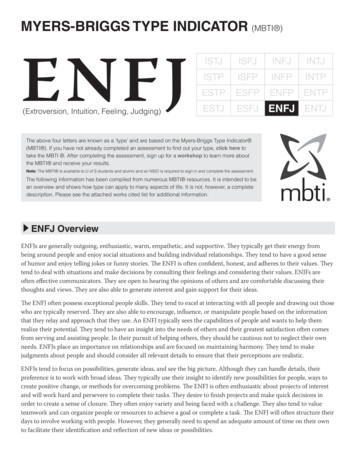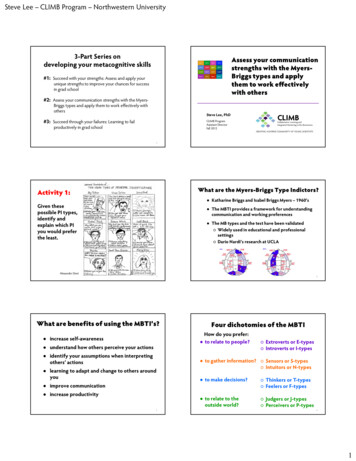
Transcription
Steve Lee – CLIMB Program – Northwestern University3-Part Series ondeveloping your metacognitive skillsAssess your communicationstrengths with the MyersBriggs types and applythem to work effectivelywith others#1: Succeed with your strengths: Assess and apply yourunique strengths to improve your chances for successin grad school#2: Assess your communication strengths with the MyersBriggs types and apply them to work effectively withothersSteve Lee, PhD#3: Succeed through your failures: Learning to failCLIMB ProgramAssistant DirectorFall 2012productively in grad schoolCLIMBCollaborative Learning andIntegrated Mentoring in the BiosciencesCREATING A DIVERSE COMMUNITY OF YOUNG SCIENTISTS1What are the Myers-Briggs Type Indictors?Activity 1: Katharine Briggs and Isabel Briggs Myers – 1960’sGiven thesepossible PI types,identify andexplain which PIyou would preferthe least. The MBTI provides a framework for understandingcommunication and working preferences The MB types and the test have been validated Widely used in educational and professionalsettings Dario Nardi’s research at UCLAAlexander Dent3What are benefits of using the MBTI’s?4Four dichotomies of the MBTIHow do you prefer: to relate to people? increase self-awareness understand how others perceive your actions identify your assumptions when interpretingothers’ actions learning to adapt and change to others aroundyou to gather information? Sensors or S-types Intuitors or N-types to make decisions? Thinkers or T-types Feelers or F-types to relate to theoutside world? Judgers or J-types Perceivers or P-types improve communication increase productivity5 Extroverts or E-types Introverts or I-types61
Steve Lee – CLIMB Program – Northwestern UniversityCommon MisconceptionsActivity 2: I can’t function as my opposite type preference abilityDiscuss the case studies andrespond to the questions If I know someone’s types, I can predict (ormanipulate) their behavior. knowing their MB types only gives aframework to understand them I need to find people with the same typesto be productive complimentary strengths can help yourweaknesses7ResourcesMBTI’s among CLIMB studentsTotalPercentagesMenWomenE/I51 / 5648% 52%E/I14 / 2637 / 30S/N66 / 4559% 41%S / N 23 / 1843 / 27T/F51 / 5648% 52%T / F 27 / 1224 / 44J/P80 / 2576% 24%J/P25 / 1355 / 12ISTJESFJXSXJ20082009201020112012E/I1/511 / 611 / 1810 / 1018 / 17S/N4/33 / 1419 / 99 / 1231 / 7T/F4/39/816 / 137 / 1315 / 19J/P5/211 / 422 / 615 / 527 / 8ENXJISTJXNFJXSFJ8 Keirsey, Please Understand Me II (1998) good reference for the MB types Rath and Conchie, Strengths Based Leadership (2009) another good assessment test Wagner and Gale; Why Partners Need ComplementaryStrengths; Gallup Press (2009) Stone, Patton, Heen, and Fisher; Difficult Conversations:How to Discuss what Matters Most (2000)910For Self-Reflection or Discussion Consider a recent fruitful working relationship. Whatmade it work out well? How can you try to repeatthose features?assess and apply your strengths Consider another difficult working relationship. Whydo you think it became so challenging? What can youlearn from this, so that you can avoid similar difficultiesand actually benefit from this challenge?to improve your chances for success How can you anticipate potential benefits andproblems with a PI that you might work with?11122
The CLIMB ProgramFall 2012Steve LeeCLIMBCollaborative Learning andIntegrated Mentoring in the BiosciencesAssess your communication strengths with the Myers-Briggs types andapply them to work effectively with othersTo help you understand and apply the Myers-Briggs personality types, discuss these case studies withinyour groups, and address the questions. These case studies have been created based upon real andhypothetical situations that a grad student might encounter. Each case study has been simplified toinvolve primarily only one of the four possible categories of the MB types, since this workshop is anintroduction into the Myers-Briggs personality types. Case 1 – John and his PIo John has been having trouble understanding his PI’s expectations and goals for his research.This is particularly frustrating for John, because he’s very friendly and gets along with mostpeople. He has weekly meetings with his PI, where he tells her all about his ups and downsfrom his research progress, along with complications and successes. John is aware that he’scommunicative and talkative, so he believes that he’s doing a good job with informing his PIabout his research progress. But occasionally his PI will ask him a particular question thatsurprises him, because John didn’t realize that his PI had wanted something else. John justwishes that she would explain more clearly what she wants and expects, so that they can workbetter together. But his PI doesn’t seem to say much during their meetings, and seemswithdrawn from John’s perspective.Questions:o Which of the 4 Myers-Briggs categories might explain their different preferences? Based upon this description, what do you think is John’s MB type? Explain your reasoning,referring to details mentioned in the case study. What do you think is the PI’s MB type? Explain your reasoning.o How might John adapt, to work better with his PI? How can he improve his understanding ofher expectations for his research? How might John use his strengths from his MB type to help resolve his problem? What underdeveloped type skills (see tables below for some ideas) might John need toaddress as he considers how to improve the communication with his PI?Case 2 – Grace and the lab managero Grace has started a new project that requires working during odd hours at night and weekends,but an unexpected conflict has begun with the lab manager. She’s been able to coordinate thenew schedule with her new project, classes and personal life, which has helped her sanity,because she likes to plan things in advance and schedule her activities. Also, she’s been able tokeep things under control by marking clear boundaries for her benchtop space and keeping herown area organized, because the rest of the lab seems messy to her most of the time. Butwhen Grace works in the lab during odd hours, she’s been having trouble finding reagents inthe lab. The reagent catalog has not been updated recently, so it’s been difficult for Grace to1
find items. During the normal working hours, the lab manager is helpful in tracking down itemsfor Grace. But on this particular Saturday Grace had to cancel an experiment because shecouldn’t find a critical reagent in the lab, and so fell behind her schedule. Grace thinks that it’sthe job of the lab manager to update the reagent catalog, and is frustrated that she had tocancel her experiment and fall behind her schedule. In her frustration, she begins to write anemail to the lab manager.Questions:o Which of the 4 Myers-Briggs categories might explain the different preferences for Grace andthe lab manager? Based upon this description, what do you think is Grace’s MB type? Explain your reasoning,referring to details mentioned in the case study. What do you think is the lab manager’ MB type? Explain your reasoning.o Do you think she should email the lab manager, or perhaps communicate with him in anothermanner? How might Grace adapt, to work better with the lab manager? How might Grace use her strengths from her MB type to help resolve her problem? What underdeveloped type skills (see tables below for some ideas) might Grace need toaddress as she considers how to improve the working relationship with the lab manager?Case 3 – Mary and her postdoco Mary enjoys working in her lab, but has started to notice problems in communicating with thepostdoc who’s been assigned to mentor her. Mary prides herself as a “do-er” who works hardand is very willing to put in extra hours in the evenings and weekends in the lab. She enjoysworking with her hands, and so has developed excellent technical skills. She prefers havingdetailed protocols that she can closely follow, so that she doesn’t have to create new protocolsor make changes. But her postdoc often asks questions during their weekly meetings about herresearch that don’t seem relevant to her, and gives her papers to read that seem to be outsideof her field. Mary has been very busy with her coursework and research, and would prefer tofocus on only her project. But the postdoc keeps bringing in ideas and papers that seem tooabstract to Mary. Furthermore, he recently asked why a particular step in the protocol wasneeded, and Mary was stumped. She felt embarrassed, because the particular step consumedan expensive reagent and she realized that she had simply followed the procedure withoutthinking carefully.Questions:o Which of the 4 Myers-Briggs category types might explain their different preferences? Based upon this description, what do you think is Mary’s MB type? Explain your reasoning,referring to details mentioned in the case study. What do you think is the postdoc’s MB type? Explain your reasoning.o How might Mary adapt, to work better with her postdoc? What might she say or ask thepostdoc? How might Mary use her strengths from her MB type to help resolve her problem? What underdeveloped type skills (see tables below for some ideas) might Mary need toaddress as she considers how to improve the communication with the postdoc?Case 4 – Tony and his new labo Tony is really glad that he and his new friend, Sheila, have joined the same lab. He also enjoysplaying with Sheila’s child, and helping take care of her baby occasionally. Their group is trying2
to decide on a new weekly time to hold their group meetings, but this has caused problemsbecause their group has recently grown bigger and it’s hard to find a new time that’sconvenient for everyone. Soon afterwards, the PI sent around an email, announcing that thenew group meetings will be held on Sunday mornings. Tony thought the group should talkabout it first, or that at least a Doodle poll should have been sent around. As Tony talked withSheila, he realized that the meeting time would be extremely inconvenient for her, becauseSheila will need to make special, expensive arrangements for childcare. Tony gentlyencouraged Sheila to speak up for herself, but she is reluctant to cause problems as a newmember of the group. Tony also hears that the new time would cause significant problems forothers in the group because of family and religious obligations. Tony would like to talk with thePI about possibly changing the meeting time, but isn’t sure how to approach the PI.Questions:o Which of the 4 Myers-Briggs category types might explain their different preferences for Tonyand his PI? Based upon this description, what do you think is Tony’s MB type? Explain your reasoning,referring to details mentioned in the case study. What do you think is the PI’s MB type? Explain your reasoning.o How might Tony communicate with his PI? How might Tony use the strengths of his type toapproach his PI? How might Tony use his strengths from his MB type to approach his PI? What underdeveloped type skills (see tables below for some ideas) might Tony need toaddress as he considers how to contribute to the decision-making process of the lab group? Case 5o Have you or someone in your group experienced similar situations, where you had differenttypes? Please share your situation: how the different preferences impacted the relationship,the consequences, if the situation changed, how you dealt with the differences, etc. Success Types in Medical Education by John Pelleyo http://www.ttuhsc.edu/SOM/success/What the Types Can Offer Each OtherEXTRAVERTS Provide the outwardly directed energy neededto move into action Offer responsiveness to what is going on in theenvironment Have a natural inclination to converse and tonetworkINTROVERTS Provide the inwardly directed energy neededfor focused reflection Offer stability from attending to enduring ideas Have a natural tendency to think and workalone3
SENSING TYPES Have a mastery of the facts and attention todetails Bring a knowledge of what materials andresources are available Appreciate knowing and doing what worksINTUITIVE TYPES Know by way of insight and attention tomeanings Bring a grasp of what is possible and what thetrends are Appreciate doing what hasn’t been triedbeforeTHINKING TYPES Take a hard look at the pros and cons ofsituations, even when they have a personalstake Able to analyze and solve problems with logicand reason Want to discover the “truth” and they naturallynotice logical inconsistenciesFEELING TYPES Know what is important to and for people, andadhere to that in the face of opposition Have an ability to build relationships and to bepersuasive Want to uncover the greatest “good” in asituation and they notice when people may beharmedJUDGING TYPES Can organize, plan, and follow through onprojects Push to get things settled and decided Appreciate well-oiled efficiency at workPERCEIVING TYPES Can respond quickly and flexibly to the needsof the moment; spontaneous Strive to keep things open so new informationmay be gathered Appreciate the need for spontaneity andexploration at workWell-developed type skillsExtraversionIntroversionActive approachReflective approachBring breadthBring depthSensingIntuitionPracticalImaginativeBrings dataBrings perspectiveThinkingFeelingAnalyze situationsAffiliate peopleBring consistencyBring harmonyJudgingPerceivingDecisiveInquisitiveBring a planBring optionsUnderdeveloped type skillsExtraversionIntroversionHyperactiveWithdrawn & secretiveSuperficialOverly seriousSensingIntuitionSlow & dullCarelessNarrow focusImpractical & dreamyThinkingFeelingCold & uncaringEasily hurtOverly competitiveOverly sentimentalJudgingPerceivingOverly opinionatedIndecisiveControllingProcrastinating4
What are the Myers-Briggs Type Indictors? Katharine Briggs and Isabel Briggs Myers -1960's The MBTI provides a framework for understanding communication and working preferences The MB types and the test have been validated Widely used in educational and professional settings Dario Nardi's research at UCLA 4

